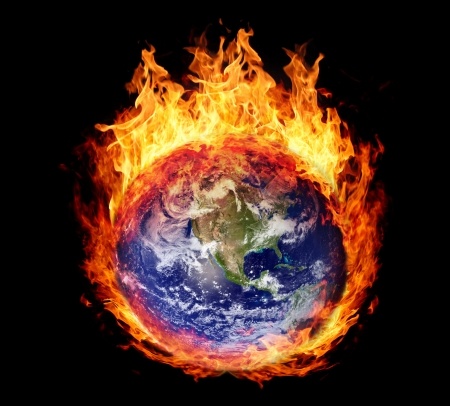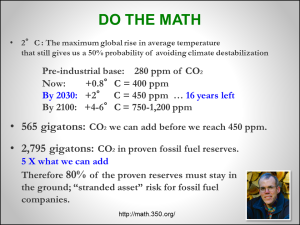Stranded Assets or Stranded Humanity – Choose one

In Canada, we are witnessing a false debate: which is safer; shipping diluted bitumen (dilbit) by pipeline or by train? Pipeline proponents point to recent train derailment disasters as evidence that the pipelines are safer. Rail proponents point to recent pipeline spills as evidence that trains are safer. We’re overlooking a third, alternative: don’t ship dilbit at all. Leave the bitumen in the oil sands. Write them off as stranded assets.
In fact, the stranded asset alternative is our only sane choice. As shown in this figure, Bill McGibbon and his Do the Math folks help us understand why. Climate scientists and world leaders agree on at least one thing: we cannot allow the average global temperature to increase above 2°C. Even at that temperature, we only have a 50:50 chance of avoiding runaway climate destabilization.
The temperature of the earth will increase by 2° when the concentration of carbon dioxide in our atmosphere reaches 450 parts per million (ppm). At our current course and speed, we will reach 450 ppm by around 2030. So, in about 16 years, all bets will be off on climate stability. We must stop the willful insanity of signing on to this “global suicide pact,” as it is famously labelled by UN Secretary-General Ban Ki-moon.
It doesn’t take much imagination, guided by climate scientists’ scenarios, to realize that climate destabilization threatens the future of humanity on this planet. Not only will we experience severe weather events and rising sea levels, we will also experience stresses on our food, water and shelter needs as oceans acidify, fertile land washes away or dries up, and wide swaths of towns and cities are devastated by severe weather events.
Ban Ki-Moon’s strident comment is backed up by the math. We can only add 565 gigatons more carbon dioxide (CO2) to the atmosphere before we reach that dangerous 450 ppm concentration. But we have at least 2,795 gigatons of CO2 trapped in proven fossil fuel reserves. That’s about five times more CO2 that we are allowed to add before we reach the tipping point: 5 x 565 = 2,825. That means we must leave 80% of our known fossil fuel reserves in the ground as stranded assets or there is a 50% probability that we will destabilize our climate by 2030. Any questions?
Meanwhile, fossil fuel companies reassure us that they can extract bitumen from the oil sands while reducing the associated inconvenient carbon emissions from their operations, using efficiencies and the unproven promise of scaled-up carbon sequestration. Pipeline companies reassure us that they can dilute the thick, viscous bitumen enough to be able to pump it safely over thousands of kilometres in pipes without dangerous and inconvenient leaks. Train companies reassure us that rail safety can be improved enough that we won’t have to worry about the occasional dangerous and inconvenient tanker car derailment.
Let’s give them all a huge benefit of the doubt. Let’s assume that oil sands operations and transportation magically have zero carbon footprints; that there will be zero pipeline leaks and zero tanker car derailments. Would that be good news or bad news?
It would be disastrous news. It would mean that we would be reassured that oil companies are doing their bit to mitigate climate change and keep us safe, when they are actually accelerating our risk by getting their product to market more easily and accelerating our head-long rush over the climate change cliff. The U.S. Congressional Research Service estimates that the final consumption phase of the “Well-to-Wheel” life-cycle of oil contributes 70%-80% of its overall emissions. Addressing the carbon footprint from oil sands operations is playing in the margins. Carbon emissions during that part of the life cycle of oil are relatively small. They are not the danger.
The danger is that the dilbit gets transported safely to refineries, refined, sold, and burned, probably in exponentially increasing fleets of cars and trucks in Asia. If it gets burned, the concentration of CO2 increases in the atmosphere. When the concentration reaches 450 ppm, there is a 50:50 chance that we will destabilize our climate. Therefore, it is irresponsibly unsafe to allow fossil fuels to get to market.
This is not about pipeline safety or tanker train safety. This is about the safety of humanity. For someone at my age and stage, 2030 is an academic date, but it is real for my adult sons and daughter, and it is very real for my three grandsons. This is about their safety and well-being. This is personal. Given a choice between stranding oil companies’ assets and stranding my kids’ and grandkids’ future along with the rest of humanity’s, the choice is easy.
Isn’t it time that we stopped subsidizing fossil fuel companies to wipe us out? Isn’t it time that we transitioned our economic model to be independent of fossil fuels? Isn’t it time we did something to stop this march of folly? Isn’t it time that we stopped pretending that we have no choice but to feed our addiction to fossil fuels? Of course.
But isn’t it “mission impossible” to change the course of humanity’s Titanic as the fossil fuel industry steers us toward the climate change iceberg? No. We can wean ourselves off fossil fuels if we decide to. It will take political courage, innovation, and rethinking what is really important to our well-being, but it can be done.
It not only can be done, it must be done. In my next blog, I’ll explore a 12-step program to fix our fossil fuel addiction.
Please feel free to add your comments and questions using the Comment link below. For email subscribers, please click here to visit my site and provide feedback.
Bob





Comments are closed.